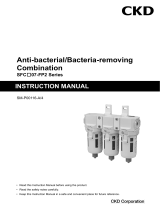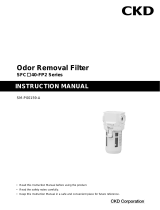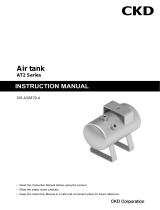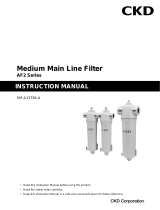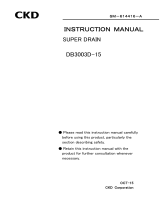Page is loading ...

INSTRUCTION MANUAL
取扱説明書
Bacteria removing filter
SFC□30-FP2 Series
SM-P00111-A/2
• Read this Instruction Manual before using the product.
• Read the safety notes carefully.
• Keep this Instruction Manual in a safe and convenient place for future reference.

SM-P00111-A/2 PREFACE
i 2023-06-05
PREFACE
Thank you for purchasing CKD's " SFC□30-FP2 Series" Bacteria removing filter.
This Instruction Manual contains basic matters such as installation and usage instructions in order to
ensure optimal performance of the product. Please read this Instruction Manual thoroughly and use the
product properly.
Keep this Instruction Manual in a safe place and be careful not to lose it.
Product specifications and appearances presented in this Instruction Manual are subject to change
without notice.
• The product is intended for users who have basic knowledge about materials, piping, electricity,
and mechanisms of pneumatic components. CKD shall not be responsible for accidents caused
by persons who selected or used the product without knowledge or sufficient training.
• Since there are a wide variety of customer applications, it is impossible for CKD to be aware of all
of them. Depending on the application or usage, the product may not be able to exercise its full
performance or an accident may occur due to fluid, piping, or other conditions. It is the
responsibility of the customer to check the product specifications and decide how the product shall
be used in accordance with the application and usage.

SM-P00111-A/2 SAFETY INFORMATION
ii 2023-06-05
SAFETY INFORMATION
When designing and manufacturing any device incorporating the product, the manufacturer has an
obligation to ensure that the device is safe. To that end, make sure that the safety of the machine
mechanism of the device, the pneumatic or water control circuit, and the electric system that controls
such mechanism is ensured.
To ensure the safety of device design and control, observe organization standards, relevant laws and
regulations, which include the following:
ISO 4414, JIS B 8370, JFPS 2008 (the latest edition of each standard), the High Pressure Gas
Safety Act, the Industrial Safety and Health Act, other safety rules, organization standards, relevant
laws and regulations
In order to use our products safely, it is important to select, use, handle, and maintain the products
properly.
Observe the warnings and precautions described in this Instruction Manual to ensure device safety.
Although various safety measures have been adopted in the product, customer's improper handling
may lead to an accident. To avoid this:
Thoroughly read and understand this Instruction Manual
before using the product.
To explicitly indicate the severity and likelihood of a potential harm or damage, precautions are
classified into three categories: "DANGER", "WARNING", and "CAUTION".
DANGER
Indicates an imminent hazard. Improper handling will cause death or
serious injury to people.
WARNING
Indicates a potential hazard. Improper handling may cause death or serious
injury to people.
CAUTION
Indicates a potential hazard. Improper handling may cause injury to people
or damage to property.
Precautions classified as "CAUTION" may still lead to serious results depending on the situation.
All precautions are equally important and must be observed.
Other general precautions and tips on using the product are indicated by the following icon.
Indicates general precautions and tips on using the product.

SM-P00111-A/2 SAFETY INFORMATION
iii 2023-06-05
Precautions on Product Use
WARNING
The product must be handled by a qualified person who has extensive knowledge and
experience.
The product is designed and manufactured as a device or part for general industrial machinery.
Use the product within the specifications.
The product must not be used beyond its specifications. Also, the product must not be modified
and additional work on the product must not be performed.
The product is intended for use in devices or parts for general industrial machinery. It is not
intended for use outdoors or in the conditions or environment listed below.
• In applications for nuclear power, railroad system, aviation, ship, vehicle, medical equipment,
and equipment that directly touches beverage or food.
• For special applications that require safety including amusement equipment, emergency shut-
off circuit, press machine, brake circuit, and safety measures.
• For applications where life or properties may be adversely affected and special safety
measures are required.
(Exception is made if the customer consults with CKD prior to use and understands the
specifications of the product. However, even in that case, safety measures must be taken to
avoid danger in case of a possible failure.)
Do not handle the product or remove pipes and devices until confirming safety.
• Inspect and service the machine and devices after confirming the safety of the entire system.
Also, turn off the energy source (air supply or water supply) and power to the relevant facility.
Release compressed air and fluid from the system and use extreme care to avoid water or
electric leakage.
• Since there may be hot or live parts even after operation has stopped, use extreme care when
handling the product or removing pipes and devices.
• When starting or restarting a machine or device that incorporates pneumatic components,
make sure that a safety measure (such as a pop-out prevention mechanism) is in place and
system safety is secured.
Although the product is not intended for use in applications or equipment that directly touches
beverage or food, FP2 Series products can be used for such applications as long as the
product is used within its specifications.

SM-P00111-A/2 CONTENTS
iv 2023-06-05
CONTENTS
PREFACE ........................................................................................................................... i
SAFETY INFORMATION .................................................................................................. ii
Precautions on Product Use .......................................................................................... iii
CONTENTS ...................................................................................................................... iv
1. PRODUCT OVERVIEW ............................................................................................. 1
1.1 Model Number Indication .................................................................................... 1
1.2 Specifications ...................................................................................................... 1
1.3 Dimensions ......................................................................................................... 2
2. INSTALLATION ......................................................................................................... 3
2.1 Environment ........................................................................................................ 3
2.2 Unpacking ........................................................................................................... 6
2.3 Mounting ............................................................................................................. 6
2.4 Piping .................................................................................................................. 6
2.4.1 Pipe cleaning .................................................................................................. 7
2.4.2 Seal material ................................................................................................... 7
2.4.3 Pipe screwing torqueeal material ................................................................... 8
2.4.4 Maintenance space ........................................................................................ 8
3. USAGE ....................................................................................................................... 9
4. MAINTENANCE AND INSPECTION ....................................................................... 10
4.1 Daily Inspection ..................................................................................................11
4.2 Periodic Inspection.............................................................................................11
4.3 How to release drainage ....................................................................................11
4.4 Maintenance ..................................................................................................... 12
4.4.1 Plastic bowl ................................................................................................... 12
4.4.2 Element ........................................................................................................ 13
5. TROUBLESHOOTING............................................................................................. 14
5.1 Problems, Causes, and Solutions .................................................................... 14
6. WARRANTY PROVISIONS ..................................................................................... 15
6.1 Warranty Conditions ......................................................................................... 15
6.2 Warranty Period ................................................................................................ 15

SM-P00111-A/2 CONTENTS
1 2023-06-05
1. PRODUCT OVERVIEW
1.1 Model Number Indication
1.2 Specifications

SM-P00111-A/2 CONTENTS
2 2023-06-05
1.3 Dimensions

SM-P00111-A/2 CONTENTS
3 2023-06-05
2. INSTALLATION
2.1 Environment
WARNING
Do not use the product in an atmosphere where sodium hypochlorite, synthetic oil, organic
solvent, chemicals, cutting oil, screw lock agent, leak detection agent, hot water, or other
hazardous factors are present or in a place where they may adhere to the product.
Deterioration may occur since the plastic bowl is made of polyamide.
Avoid using the product if compressed air contains chemicals, in an atmosphere where
chemicals are present, or in a place where chemicals may adhere.
When used in the above environment, the plastic bowl may become damaged and this may lead
to accidents.
For more information about the chemical resistance of the plastic bowl, refer to the table
"Chemical resistance of plastic".
Prevent the generated ozone from passing through the filter.
Deterioration of the filter element may occur. Use extreme care when using the product in
combination with equipment which generates ozone (such as an ionizer).
If the hollow fiber membrane in the bacteria removing filter suffers oxidative degradation
from ozone or ultraviolet in the fluid, it may be damaged and allow flow over to the
secondary side. Implement periodic inspections and exchange.
Consult the graph below for standard replacement times.
Relation between ozone concentration
and integration quantity
Filter element replacement time

SM-P00111-A/2 CONTENTS
4 2023-06-05
CAUTION
Observe the following precautions regarding the ambient environment.
• Do not use the product where there is direct irradiation of ultraviolet rays.
• Avoid installing the product where it is exposed to direct sunlight.
• Avoid installing the product where it is subject to vibrations and shocks.
Install an air dryer, an air filter, and an oil mist filter on the primary side to remove moisture
and oil.
Make sure that substances such as chlorine do not become mixed with the compressed air
when using a water lubricated type compressor circuit.
Install an air dryer and a drain separator before the air filter if there is a large amount of
drainage.
The odor removal filter does not remove drainage. An excessive amount of drainage from the
compressor may cause the air to become hot and highly humid and this may lead to lower
durability or corrosion of the product.
Do not use the product in an environment where:
• Ambient temperature is outside the range of 5°C to 45°C
• Air can freeze
• Water drop or cutting oil can splash onto the product
• Condensation may occur due to high humidity and temperature change
• Sea breeze or seawater can splash onto the product
• Atmosphere contains corrosive gas, fluids, or chemicals
• Atmosphere contains a lot of dust
• Atmosphere contains spatter
• It is exposed to direct sunlight, rain, wind, or water
• There is a heat source in the surrounding area and heat is radiated
• Ozone is produced
Anti-bacterial/
bacteria-removing/
filter

SM-P00111-A/2 CONTENTS
5 2023-06-05
Chemical resistance of plastic
Type of
chemicals
Classification
Major chemical products
Example of general use
Nylon
bowl
Inorganic
chemicals
Acid
Sodium hypochlorite, hydrochloric acid,
sulfuric acid, hydrofluoric acid, phosphoric acid,
and chromic acid
Pickling solution for metal,
acidic degreasing solution,
and film treatment solution
N
Alkali
Alkaline substances such as caustic soda,
caustic potash, slaked lime, ammonia water,
and sodium carbonate
Alkaline degreasing solution for metal, water-
soluble cutting oil agent,
and leak detection agent
Y
Inorganic
salt
Sodium sulfide, sodium nitrate,
potassium dichromate, and sodium sulfate
Y
Organic
chemicals
Aromatic
hydrocarbon
Benzene, toluene, xylene, ethylbenzene,
and styrene
Included in paint thinner
(benzene, toluene, and xylene)
N
Chlorinated
aliphatic
hydrocarbon
Methyl chloride, ethylene chloride, methylene
chloride, acetylene chloride, chloroform,
trichlene, berklene, and carbon tetrachloride
Organic solvent cleaning solution for metal
(trichlene, berklene, carbon tetrachloride, etc.)
Y
Chlorinated
aromatic
hydrocarbon
Chloro-benzene, dichloro-benzene,
and benzene hexachloride (B, H, C)
Agricultural chemicals
Y
Petroleum
composition
Solvent naphtha, gasoline, and kerosene
Y
Alcohol
Methyl alcohol, ethyl alcohol, cyclohexanol,
and benzyl alcohol
Anti-freezing agent
and leak detection agent
N
Phenol
Carbolic acid, cresol, and naphthol
Antiseptic solution
N
Ether
Methyl ether, ethyl methyl ether,
and ethyl ether
Additive for brake oil
Y
Ketone
Acetone, methyl ethyl ketone,
Cyclohexanone, and acetophenone
N
Carboxylic
acid
Formic acid, acetic acid, butyric acid,
acrylic acid, oxalic acid, and phthalic acid
Stain, aluminum treatment agent (oxalic acid),
base material for paint (phthalic acid),
and leak detection agent
N
Ester
Dimethyl phthalate (DMP),
diethyl phthalate (DEP), dibutyl phthalate (DBP),
and dioctyl phthalate (DOP)
Additive for lubrication oil, synthetic oil,
and rust preventive oil
Plasticizer for synthetic resins
Y
Hydroxy
acid
Glycolic acid, lactic acid, malic acid, citric acid,
and tartaric acid
N
Nitro
compound
Nitromethane, nitroethane, nitroethylene,
and nitrobenzene
Y
Amine
Methylamine, dimethylamine, ethylamine,
aniline, and acetanilide
Additive for brake oil
N
Nitrile
Acetonitrile, acrylonitrile, benzonitrile,
and acetisonitrile
Raw material for nitrile rubber
Y
Y: Resistant; N: Not resistant (Plastic will break.)

SM-P00111-A/2 CONTENTS
6 2023-06-05
2.2 Unpacking
CAUTION
Do not open the packing of the product until just before piping to prevent foreign matters
from entering the product.
• Check that the model number ordered and the model number indicated on the product are the same.
• Check the exterior of the product for any damage.
2.3 Mounting
◼ Filter installation order
Install the filters in the order shown below.
2.4 Piping
WARNING
Do not apply pipe loads or torque to the body and the pipes.
<Piping load torque>
Series
SFC330
SFC430
SFC830
Max. torque
(N·m)
50
50
100
Antibacterial pre-filter
High-performance
anti-bacterial filter
Deodorizing filter
Bacteria removing
filter
IN
OUT

SM-P00111-A/2 CONTENTS
7 2023-06-05
CAUTION
Fully flush and clean the pipes before use.
Residual dust or foreign matter in a pipe may cause operation fault.
Connect the pipes correctly according to the direction of flow by checking the direction of
the arrow.
Prevent foreign matters from entering the pipes while piping and connecting the fitting.
Be careful not to allow cutting chips from the piping screw and seal material from entering the
pipes while piping and connecting the fitting.
Residual dust or foreign matter in a pipe may cause lower performance of the product.
Tighten the pipes with the appropriate tightening torque.
Do not subject the body and the pipes to a bending moment that is due to pipe loads.
Firmly secure and install the product with the specified bracket, a stand, or a pipe support.
Do not apply high pressure suddenly when supplying compressed air for the first time after
connecting the pipes/tubes.
Sudden introduction of highly-pressurized air may cause the tubes to become disconnected and
jump around and an accident may occur.
2.4.1 Pipe cleaning
Before piping, blow air into the pipes to clean the interior and to remove cutting chips and foreign
matters.
2.4.2 Seal material
Apply a seal tape or seal material to the screw threads leaving two or more threads at the pipe end
uncovered or uncoated. If the pipe end is fully covered or coated, a shred of seal tape or residue of seal
material may enter inside of the pipes or device and cause a failure.
When using a seal tape, wind it around the screw threads in the direction opposite from the screw
threads and press it down with your fingers to attach it firmly.
When using a liquid seal material, be careful not to apply it to resin parts. The resin parts can become
damaged and this may lead to a failure or malfunction.
Also, do not apply seal material to the internal threads.
Seal tape
Seal material (solid or liquid)
Correct
Correct
Incorrect
Incorrect
Leave
two threads

SM-P00111-A/2 CONTENTS
8 2023-06-05
2.4.3 Pipe screwing torqueeal material
Do not apply excessive torque to the body and the pipes when piping.
Series
SFC330
SFC430
SFC830
Max. torque
(N·m)
30
30
70
2.4.4 Maintenance space
Secure sufficient space under the bowl for taking out parts when disassembling and cleaning.
Series
SFC330, SFC430, SFC830
Maintenance space (H)
At least 60

SM-P00111-A/2 CONTENTS
9 2023-06-05
3. USAGE
WARNING
Use the product within the specifications.
Ventilate sufficiently when using the product with nitrogen gas (N2) or carbon dioxide (CO2).
Do not use the product for medical purposes or in any equipment or circuit that concerns
human life.
The product is designed for industrial use.
CAUTION
Check the working circuit and the working fluid.
Do not subject the product to vibration, impact, or other external forces such as those
caused by swinging tubes.
Use the product within the maximum processing flow rate.
Use the product within the maximum working pressure and differential pressure resistance.
Use the product so that the pressure difference between the IN side and the OUT side does
not exceed 0.1 MPa.
• This product is manufactured and packaged in an environment where particles are
managed and monitored but suppression of bacterial adhesion and generation is not
considered.
• The product itself is not subjected to any special sterilization/bacteria-removing treatment
(such as autoclave sterilization).
• The odor removal filter does not have antibacterial/bacteria-removing function.
• The odor removal filter adsorbs and removes oil vapor contained in the compressed air
(nitrogen gas and carbon dioxide). Activated carbon absorbs certain substances easily and
certain substances not so easily. Not all odors can be adsorbed and removed.
• The product cannot be used as an absolute filter since it does not provide absolute filtration.
• The secondary oil concentration given in the catalog is the actual value determined under
our specified conditions with an oil mist filter (M type of M Series) installed on the primary
side.
◼ Maximum processing flow rate
Make sure the flow rate does not exceed the values shown in the graph below.

SM-P00111-A/2 CONTENTS
10 2023-06-05
4. MAINTENANCE AND INSPECTION
WARNING
Stop supplying the pressure and make sure that there is no residual pressure before
maintenance.
Perform periodic inspections at least once every six months to detect cracks, scratches,
and other deteriorations on the plastic bowl.
Cracks, scratches, or other deteriorations may cause damage. Replace the bowl with a new
plastic bowl or a product.
Check for dirt on the plastic bowl periodically.
If the bowl is dirty, replace the bowl.
When cleaning, remove dirt using a diluted household detergent and then rinse well with clean
water to prevent damage to the product.
Remove air filter drain.
Components could malfunction if drainage flows into the secondary side.
The resin bowl must not be filled above the "upper drain limit" or "MAX LEVEL" markings
stamped on the bowl guard.
Before removing the bowl assembly, stop supplying the compressed air, release the
pressure from the bowl, and check that there is no residual pressure in the bowl.
CAUTION
Thoroughly read and understand the Instruction Manual supplied with the product before
use and maintenance.
Inspect and replace the filter element periodically.
Performance degradation may occur if the filter element is clogged. Make sure your hands are
clean when attaching the new element.
When replacing the element, make sure not to let bacteria, dusts, and foreign matters that
have adhered on the primary side flow into the secondary side.
Do not hold the filter paper when attaching or removing the filter element.
The product may become damaged or may not be able to exercise its full performance.
Do not use alcohol to disinfect or clean the product.
Deterioration or damage of the plastic parts may occur.
Do not modify the product.

SM-P00111-A/2 CONTENTS
11 2023-06-05
4.1 Daily Inspection
• Thoroughly read and understand this Instruction Manual before maintenance and inspection.
• Check that the product operates properly before starting use.
4.2 Periodic Inspection
• In order to use the product under optimum conditions, perform a periodic inspection every six
months.
• It is recommended to check that there is no leakage from the pipes.
4.3 How to release drainage
Drainage starts when the cock is turned to O side, and the discharge stops when the Tighten by hand in
the S direction.

SM-P00111-A/2 CONTENTS
12 2023-06-05
4.4 Maintenance
4.4.1 Plastic bowl
◼ Detaching the plastic bowl

SM-P00111-A/2 CONTENTS
13 2023-06-05
4.4.2 Element
Affix the maintenance label to the product to serve as a reminder of when to replace the element.
Replace the element with a new one after one year of use (6,000 hours) or when the pressure drop
reaches 0.1 MPa.
This replacement period is for reference only. The service life of the product may be shortened
depending on the condition of use and the environment.
<Replacement element>
Element model No
Bacteria removing filter
element
Model
SFC330
SFC330-ELEMENT
SFC430
SFC430-ELEMENT
SFC830
SFC830-ELEMENT
Washing and cleaning will not make the element reusable.
◼ Removing the Bacteria removing filter element
<SFC330, SFC430 element >
<SFC830 element >
If it is difficult to turn by hand, you can use a wrench on the four corners of the element body
(housing) to turn it.
◼ Attaching the Bacteria removing filter element
1 Apply a thin coat of NSF H1 food-grade grease to the O-ring attached to the element,
then install the O-ring on the element.
2 When assembling to the body, hold the housing part.
3 Use a turning torque of about 2 N・m when installing.

SM-P00111-A/2 CONTENTS
14 2023-06-05
5. TROUBLESHOOTING
5.1 Problems, Causes, and Solutions
If the product does not operate as intended, check the table below for a possible solution.
Problem
Cause
Solution
Particles (bacteria) come out right
after the Bacteria removing filter.
Element has reached the
end of its service life.
Stop supplying the compressed air, remove the
bowl assembly, and replace the element.
Maximum processing flow
rate is exceeded.
Replace with a model suitable for the working flow
rate.
Fluid does not flow.
Pressure drop is large.
Element has reached the
end of its service life.
Stop supplying the compressed air, remove the
bowl assembly, and replace the element.
Drainage does not discharge when
drain cock is opened.
Foreign matter in the
discharge port is clogged.
Stop supplying the compressed air, remove the
bowl assembly, and clean or replace the bowl
assembly.
Air leaks from drain port.
Drain is damaged, or drain
port is clogged with foreign
matters.
Stop supplying the compressed air, remove the
bowl assembly, and clean the inside of the bowl.
If the problem persists after cleaning, replace the
bowl assembly.
Air leaks from where bowl is
mounted.
There are scratches or
foreign matters on O-ring
for bowl sealing.
Stop supplying the compressed air, remove the
bowl assembly, and clean or replace the O-ring.
Bowl is damaged.
Stop supplying the compressed air, remove the
bowl assembly, and replace the bowl assembly.
If you have any other questions or concerns, contact your nearest CKD sales office or distributor.

SM-P00111-A/2 CONTENTS
15 2023-06-05
6. WARRANTY PROVISIONS
6.1 Warranty Conditions
◼ Warranty coverage
If the product specified herein fails for reasons attributable to CKD within the warranty period
specified below, CKD will promptly provide a replacement for the faulty product or a part
thereof or repair the faulty product at one of CKD’s facilities free of charge.
However, following failures are excluded from this warranty:
• Failure caused by handling or use of the product under conditions and in environments not
conforming to those stated in the catalog, the Specifications, or the Instruction Manual.
• Failure caused by use of the product exceeding its durability (cycles, distance, time, etc.) or caused
by consumable parts.
• Failure not caused by the product.
• Failure caused by use not intended for the product.
• Failure caused by modifications/alterations or repairs not carried out by CKD.
Failure caused by reasons unforeseen at the level of technology available at the time of delivery.
• Failure caused by acts of nature and disasters beyond control of CKD.
The warranty stated herein covers only the delivered product itself. Any loss or damage induced by
failure of the delivered product is excluded from this warranty
◼ Confirmation of product compatibility
It is the responsibility of the customer to confirm compatibility of the product with any system,
machinery, or device used by the customer.
◼ Others
The terms and conditions of this warranty stipulate basic matters.
When the terms and conditions of the warranty described in individual specification drawings or the
Specifications are different from those of this warranty, the specification drawings or the Specifications
shall have a higher priority.
6.2 Warranty Period
The product specified herein is warranted for one 1 year from the date of delivery to the location
specified by the customer.
/


